Lexus GS350 2007 Using the front audio system / LEXUS 2007 GS430/350 OWNER'S MANUAL (OM30A04U)
Manufacturer: LEXUS, Model Year: 2007, Model line: GS350, Model: Lexus GS350 2007Pages: 562, PDF Size: 17.95 MB
Page 181 of 562

161
2-4. Using other driving systems
2
When driving
To disable TRAC and/or VSC
If the vehicle gets stuck in fresh snow or mud, TRAC and VSC may
reduce power from the engine to the wheels. You may need to turn the
system off to enable you to rock the vehicle in order to free it.
■ T
urning off TRAC only
Quickly push and release the but-
ton to turn off TRAC.
The slip indicator light should come
on.
Push the button again to turn the
sy
stem back on.
■ Turning off both TRAC and VSC
Push and hold the button for more
than 3 seconds while the v
ehicle is
stopped to turn off TRAC and
VSC.
The slip and VSC OFF indicator
light should come on.
Push the button again to turn the
sy
stem back on.
Page 182 of 562
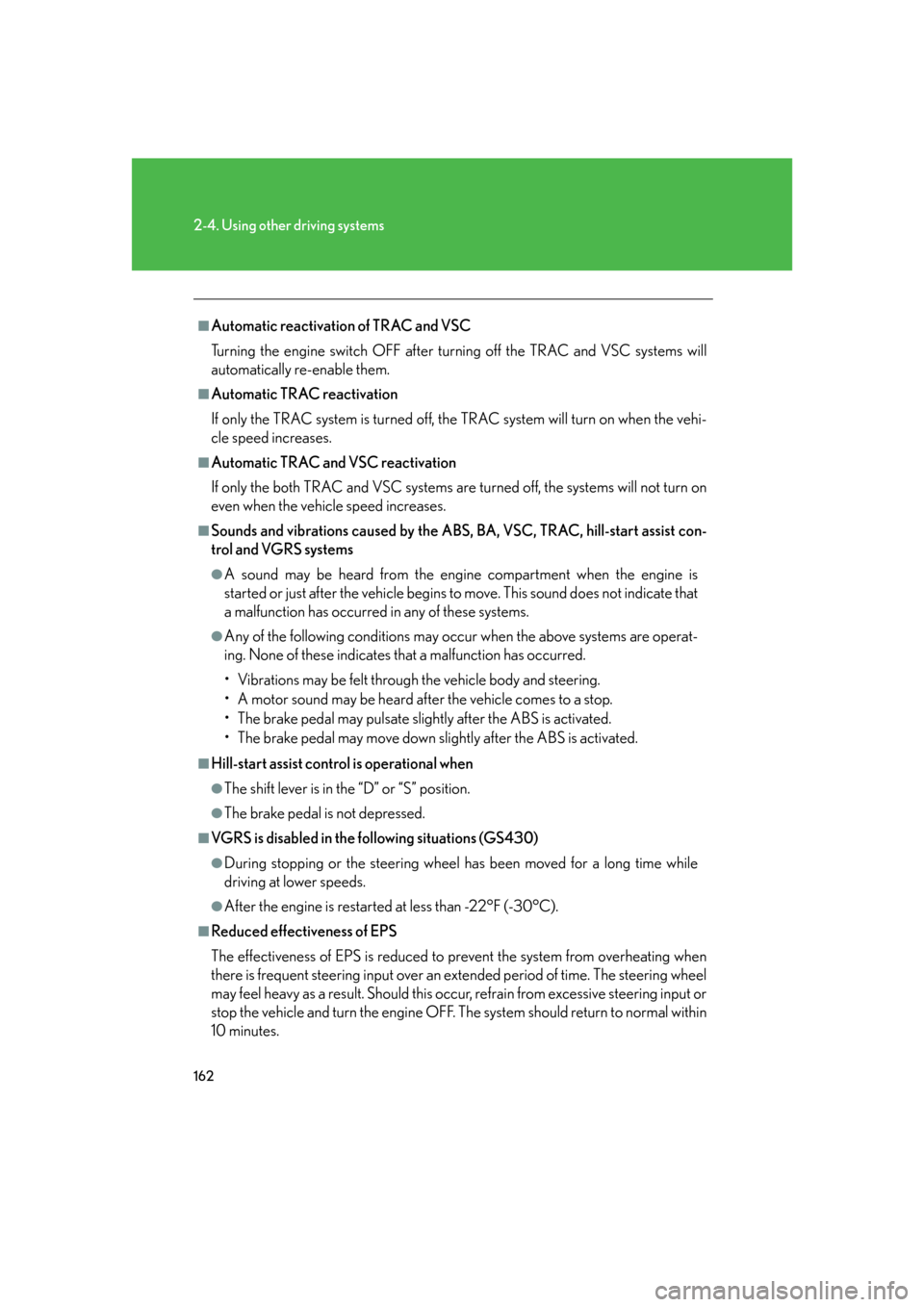
162
2-4. Using other driving systems
■Automatic reactivation of TRAC and VSC
Turning the engine switch OFF after turning of
f the TRAC and VSC systems will
automatically re-enable them.
■Automatic TRAC reactivation
If only the TRAC system is turned off, th e
TRAC system will turn on when the vehi-
cle speed increases.
■Automatic TRAC and VSC reactivation
If only the both TRAC and VSC systems are tur
ned off, the systems will not turn on
even when the vehicle speed increases.
■Sounds and vibrations caused by the ABS, BA, VSC, TRAC, hill-start assist con-
trol and VGRS systems
●A sound may be heard from the engine compartment when the engine is
started or just after the vehicle begins to move. This sound does not indicate that
a malfunction has occurred in any of these systems.
●Any of the following conditions may occur when the above systems are operat -
ing. None of these indicates that a malfunction has occurred.
• Vibrations may be felt through the vehicle body and steering.
• A motor sound may be heard after the vehicle comes to a stop.
• The brake pedal may pulsate slightly after the ABS is activated.
• The brake pedal may move down slightly af
ter the ABS is activated.
■Hill-start assist control is operational when
●The shift lever is in the “D” or “S” position.
●The brake pedal is not depressed.
■VGRS is disabled in the following situations (GS430)
●During stopping or the steering wheel has been moved for a long time while
driving at lower speeds.
●After the engine is restarted at less than -22°F (-30°C).
■Reduced effectiveness of EPS
The effectiveness of EPS is reduced to prevent the system from overheating when
th
ere is frequent steering input over an extended period of time. The steering wheel
may feel heavy as a result. Should this occur, refrain from excessive steering input or
stop the vehicle and turn the engine OFF. Th e system should return to normal within
10 minutes.
Page 183 of 562

163
2-4. Using other driving systems
2
When driving
CAUTION
■The ABS does not operate effectively when
●The limits of tire gripping performance have been exceeded.
●The vehicle hydroplanes while driving at high speed on the wet or slick road.
■Stopping distance when the ABS is operating on the wet or slick roads
The ABS is not designed to shorten the ve hicle’s stopping distance. Always main-
tain a sufficient distance from the vehicle in front of you in the following situations.
●When driving on dirt, gravel or snow-covered roads
●When driving with tire chains
●When driving over bumps in the road
●When driving over roads with potholes or roads with uneven pavement
■TRAC may not operate effectively when
Directional control and power may not be ac hievable while driving on slippery road
surfaces, even if the TRAC is operating.
Do not drive the vehicle in conditions where stability and power may be lost.
Page 184 of 562
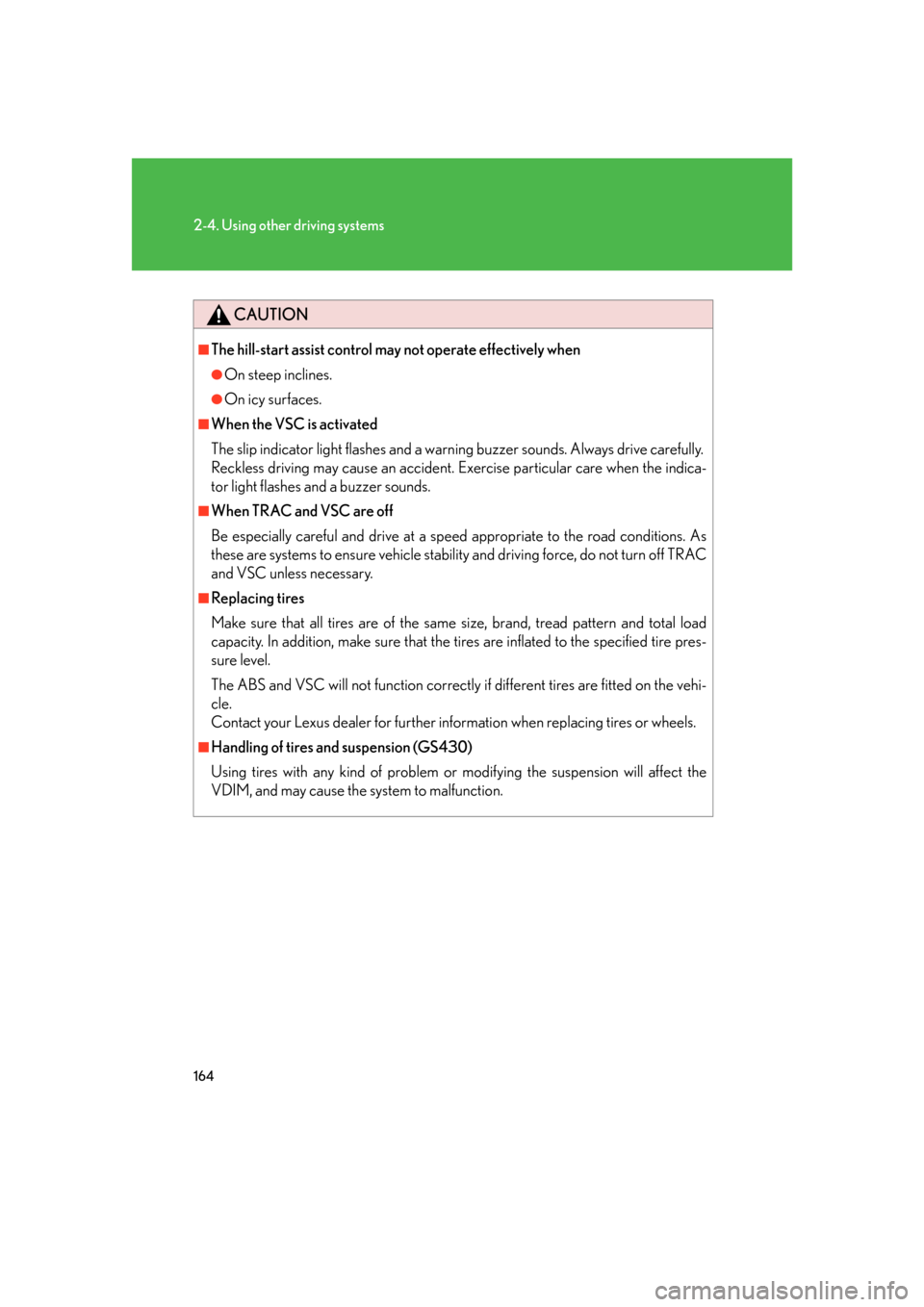
164
2-4. Using other driving systems
CAUTION
■The hill-start assist control may not operate effectively when
●On steep inclines.
●On icy surfaces.
■When the VSC is activated
The slip indicator light flashes and a warning buzzer sounds. Always drive carefully.
Reckless driving may cause an accident. Exercise particular care when the indica-
tor light flashes and a buzzer sounds.
■When TRAC and VSC are off
Be especially careful and drive at a speed appropriate to the road conditions. As
these are systems to ensure vehicle stability and driving force, do not turn off TRAC
and VSC unless necessary.
■Replacing tires
Make sure that all tires are of the same size, brand, tread pattern and total load
capacity. In addition, make sure that the ti res are inflated to the specified tire pres-
sure level.
The ABS and VSC will not function correctly if different tires are fitted on the vehi-
cle.
Contact your Lexus dealer for further info rmation when replacing tires or wheels.
■Handling of tires and suspension (GS430)
Using tires with any kind of problem or modifying the suspension will affect the
VDIM, and may cause the system to malfunction.
Page 185 of 562

165
2-4. Using other driving systems
2
When driving
PCS (Pre-Collision System) (if equipped)
Radar sensor
Detects vehicles or other obsta-
cles on or near the road ahead and
determines whether a collision is
imminent based on the position,
speed, and heading of the obsta -
cles.
Grille cover
Radar sensor
Safety systems such as the brakes and seat belts are automatically
engaged to lessen impact and injuries to occupants as well as vehicle dam
-
age when the radar sensor detects a
n unavoidable frontal collision.
■Pre-collision seat belts (front seats only)
The seat belts are immediately retracted as the effect of the pretensioner is
increased ( P. 3 5 ), to provide even greater constraining force to protect
the driver and passengers. In the event of sudden braking or skidding, the
s
ystem will operate even if no obstacle has been detected.
■Pre-collision brake assist
Applies greater braking force in relation to how strongly the brake pedal is
depressed.
■ Pre-collision AVS
If the system determines that the collision is unavoidable, the operation of
AV S ( P. 1 5 8 ) helps prevent the vehicle front from going down when
hard brakes are applied.
■Obstacles not detected
The sensor cannot detect plastic obstacles such as pylons. There may also be occa -
sions when the sensor cannot detect pedestrians, animals, bicycles, motorcycles,
tr
ees, or snowdrifts.
Page 186 of 562

166
2-4. Using other driving systems
■The pre-collision system is operational when
●Seat belt (linked to the radar sensor)
• Vehicle speed is above 3 mph (5 km/h).
• The speed at which your vehicle is approaching the obstacle or oncoming vehicle exceeds 18 mph (30 km/h).
• The front occupants are wearing a seat belt.
●Seat belts (linked to brake operation)
• Vehicle speed exceeds 9 mph (15 km/h).
• The system detects sudd en braking or skidding.
• The front occupants are wearing a seat belt.
•VSC is not turned off.
●Brake Assist
• Vehicle speed is above 18 mph (30 km/h).
• The speed at which your vehicle is approaching the obstacle or oncoming vehicle exceeds 18 mph (30 km/h).
• The brake pedal is depressed.
●AV S
• Vehicle speed is above 3 mph (5 km/h).
• The speed at which your vehicle is approaching the obstacle or oncoming vehicle exceeds 18 mph (30 km/h).
■Conditions that may trigger the system even if there is no danger of collision
●When there is an object by the roadside at the entrance to a curve
●When passing an oncoming vehicle on a curve
●When driving over a narrow iron bridge
●When there is a metal object on the road surface
●When driving on an uneven road surface
●When passing an oncoming vehicle on a left-turn
●When your vehicle rapidly closes on the vehicle in front
When the system is activated in the situations described above there is also a possi-
bility that the seat belts will retract quickly and the brakes will be applied with a force
greater than normal. When the seat belt is locked in the retracted position, stop the
vehicle in a safe place, release the seat belt and refasten.
■When there is a malfunction in the system
Warning lights and/or warning messages will turn on or flash. ( P. 451, 458)
Page 187 of 562

167
2-4. Using other driving systems
2
When driving
CAUTION
■Handling the radar sensor
Observe the following to ensure the pre-collision system can function effectively.
●Keep the sensor and front grille clean at all times.
Clean the sensor and front grille with a so ft cloth so you do not mark or damage
them.
●Do not subject the sensor or surrounding area to a strong impact.
If the sensor moves even slightly off position, the system may malfunction. If the
sensor or surrounding area are subject to a strong impact, always have the area
inspected and adjusted by a Lexus dealer.
●Do not disassemble the sensor.
●Do not attach accessories or stickers to the sensor, grille cover or surrounding
area.
■Limitations of the pre-collision system
Do not rely on the pre-collision system. Always drive safely, taking care to observe
your surroundings and checking for any obstacles or other road hazards.
Page 188 of 562
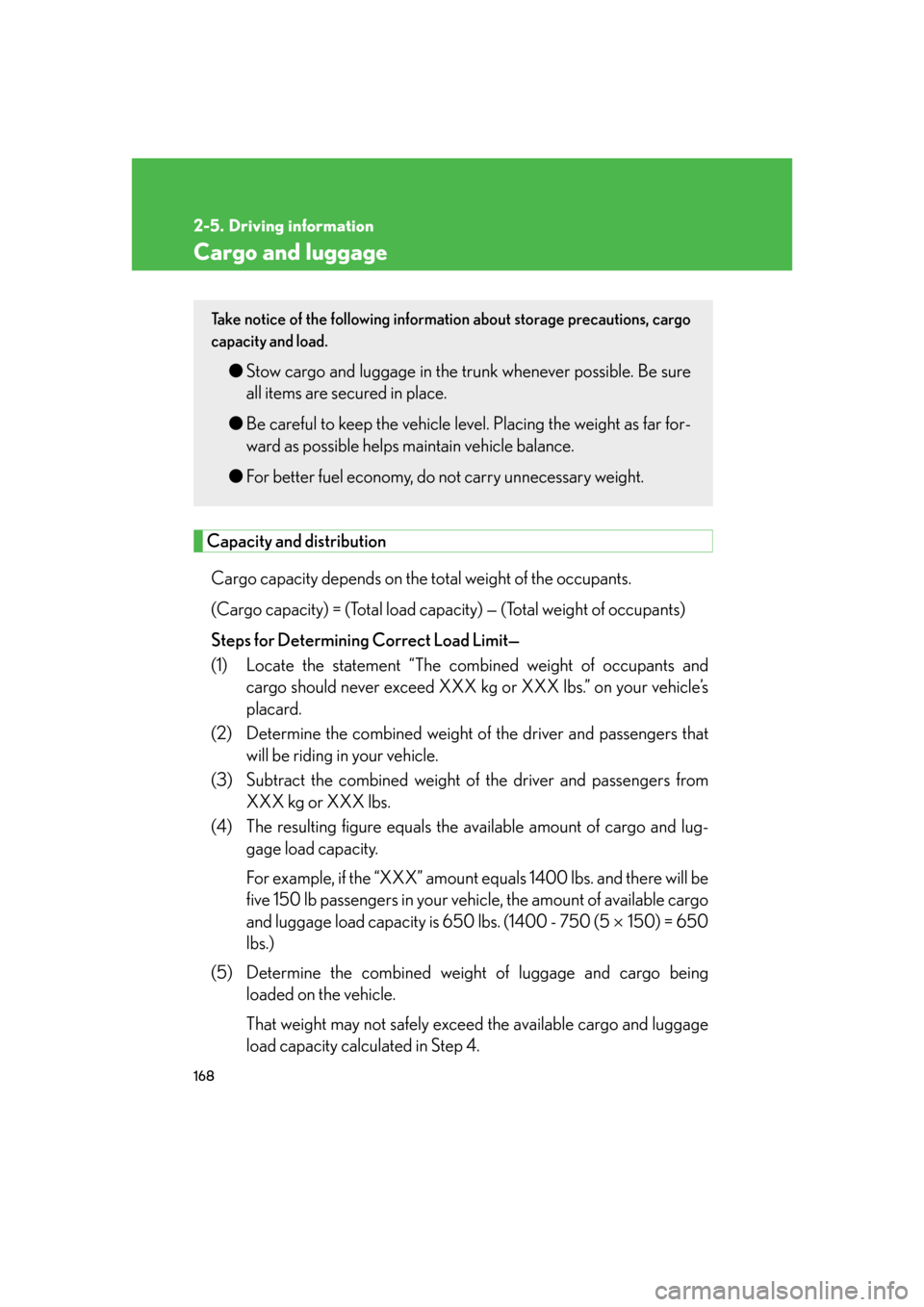
168
2-5. Driving information
Cargo and luggage
Capacity and distribution
Cargo capacity depends on the total weight of the occupants.
(Cargo capacity) = (Total load capa city) — (T
otal weight of occupants)
Steps for Determining Correct Load Limit—
(1) Locate the statement “The combined weight of occupants and car
go should never exceed XXX kg or XXX lbs.” on your vehicle’s
placard.
(2) Determine the combined weight of the driv
er and passengers that
will be riding in your vehicle.
(3) Subtract the combined weight of the driv
er and passengers from
XXX kg or XXX lbs.
(4) The resulting figure equals the av ailable amount of car
go and lug-
gage load capacity.
For example, if the “XXX” amount equals 1400 lbs. and ther
e will be
five 150 lb passengers in your vehicl e, the amount of available cargo
and luggage load capacity is 650 lbs. (1400 - 750 (5 150) = 650
lbs.)
(5) Determine the combined weight of luggage and car
go being
loaded on the vehicle.
That weight may not safely exceed the available cargo and luggage
load capacity calculated in Step 4.
Take notice of the following informat ion about storage precautions, cargo
capacity and load.
● Stow cargo and luggage in the trunk whenever possible. Be sure
all items are secured in place.
● Be car
eful to keep the vehicle level. Placing the weight as far for -
ward as possible helps maintain vehicle balance.
● F
or better fuel economy, do not carry unnecessary weight.
Page 189 of 562
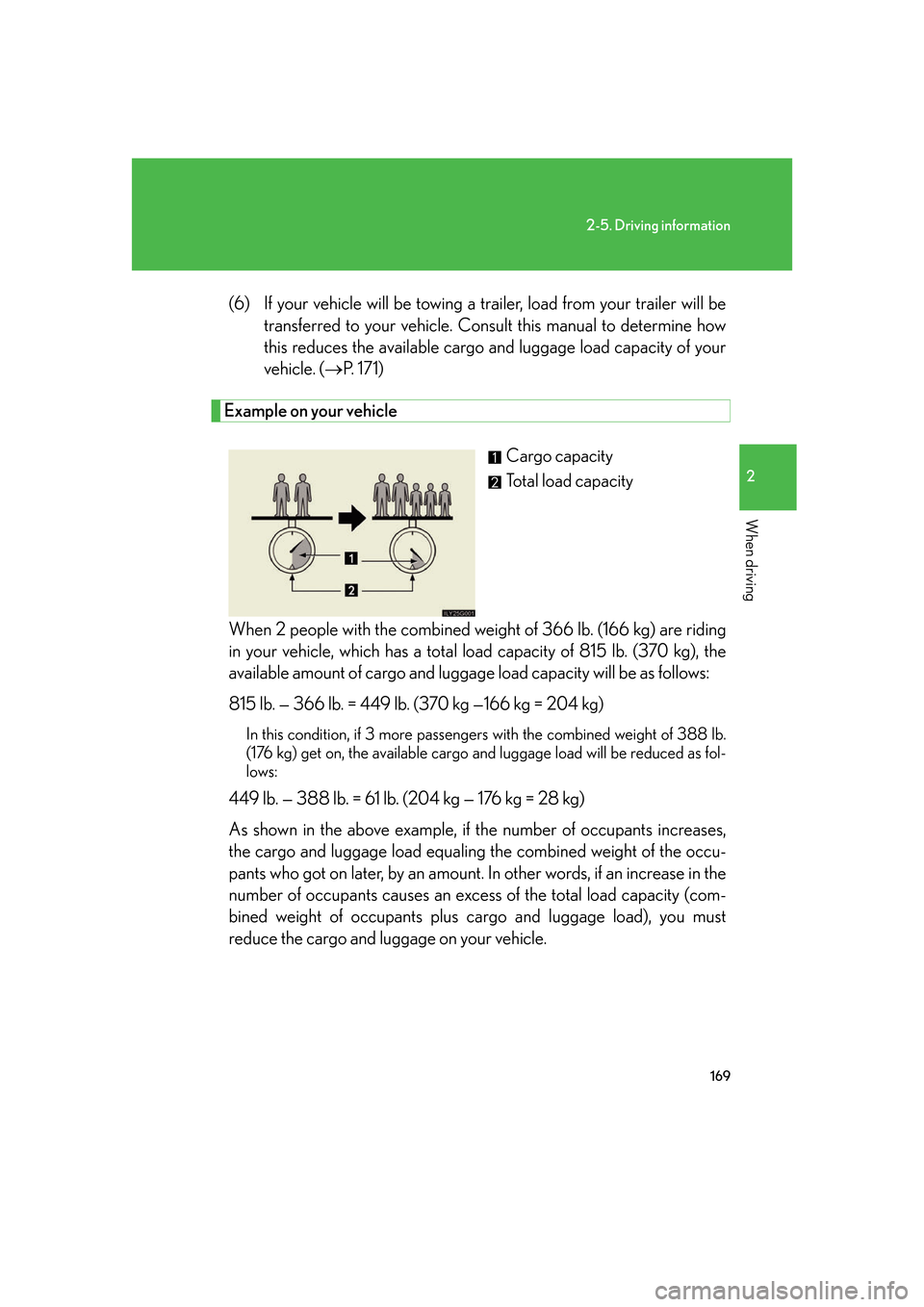
169
2-5. Driving information
2
When driving
(6) If your vehicle will be towing a trailer, load from your trailer will be transferred to your vehicle. Co nsult this manual to determine how
this reduces the available cargo and luggage load capacity of your
vehicle. ( P. 171 )
Example on your vehicle
Cargo capacity
Total load capacity
When 2 people with the combined wei ght of 366 lb
. (166 kg) are riding
in your vehicle, which has a total load capacity of 815 lb. (370 kg), the
available amount of cargo and luggag e load capacity will be as follows:
815 lb. — 366 lb. = 449 lb. (370 kg —166 kg = 204 kg)
In this condition, if 3 mo re passengers with the combined weight of 388 lb.
(176 kg) get on, the available cargo and luggage load will be reduced as fol -
lows:
449 lb. — 388 lb. = 61 lb. (204 kg — 176 kg = 28 kg)
As shown in the above example, if the number of occupants incr
eases,
the cargo and luggage load equaling the combined weight of the occu-
pants who got on later, by an amount. In other w
ords, if an increase in the
number of occupants causes an excess of the total load capacity (com -
bined weight of occupants plus car go and luggage load), y
ou must
reduce the cargo and luggage on your vehicle.
Page 190 of 562
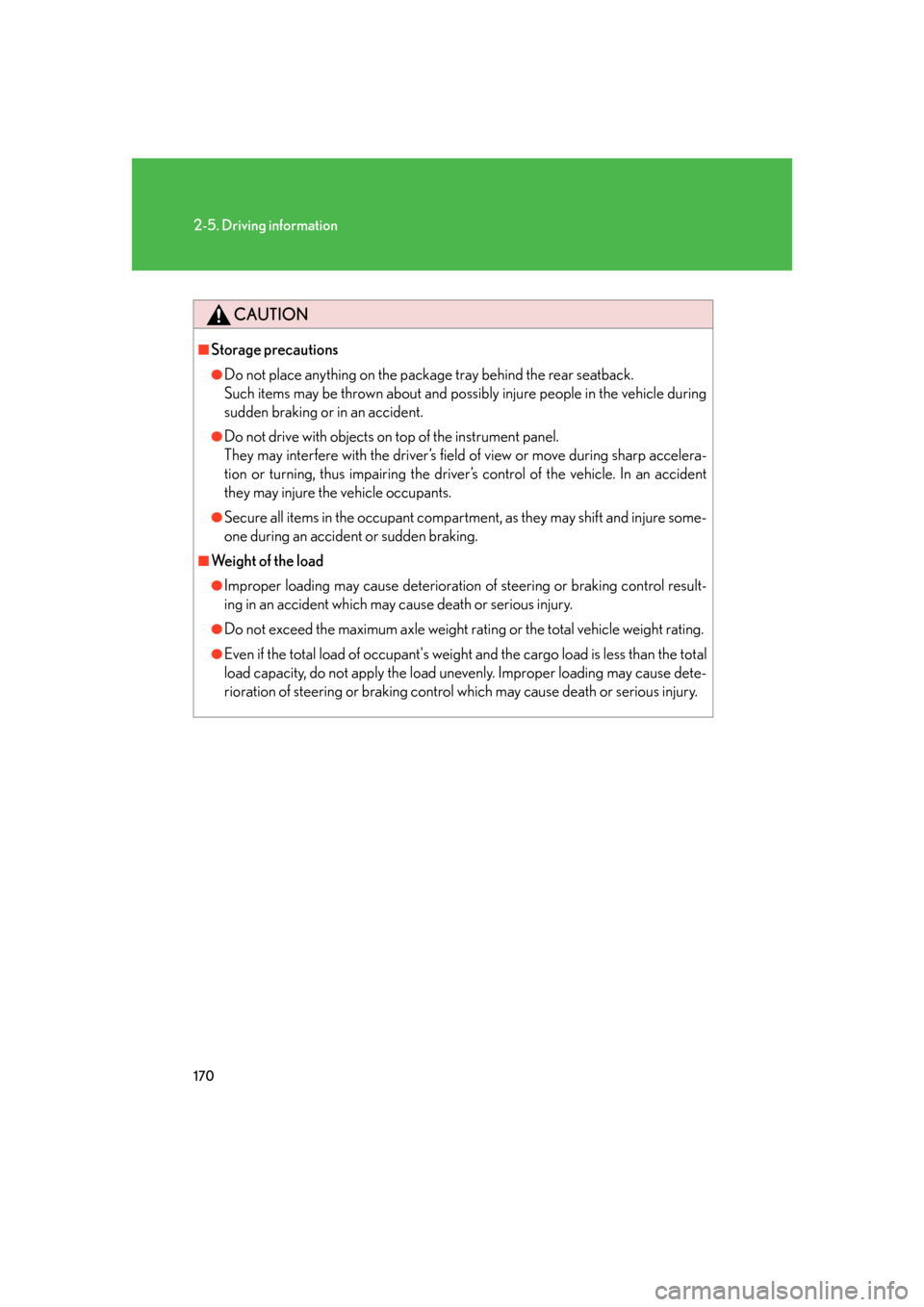
170
2-5. Driving information
CAUTION
■Storage precautions
●Do not place anything on the package tray behind the rear seatback.
Such items may be thrown about and possib ly injure people in the vehicle during
sudden braking or in an accident.
●Do not drive with objects on top of the instrument panel.
They may interfere with the driver’s field of view or move during sharp accelera-
tion or turning, thus impairing the driver ’s control of the vehicle. In an accident
they may injure the vehicle occupants.
●Secure all items in the occupant compartment, as they may shift and injure some-
one during an accident or sudden braking.
■Weight of the load
●Improper loading may cause deterioration of steering or braking control result-
ing in an accident which may cause death or serious injury.
●Do not exceed the maximum axle weight ra ting or the total vehicle weight rating.
●Even if the total load of occupant's weight and the cargo load is less than the total
load capacity, do not apply the load unevenly. Improper loading may cause dete-
rioration of steering or braking control which may cause death or serious injury.